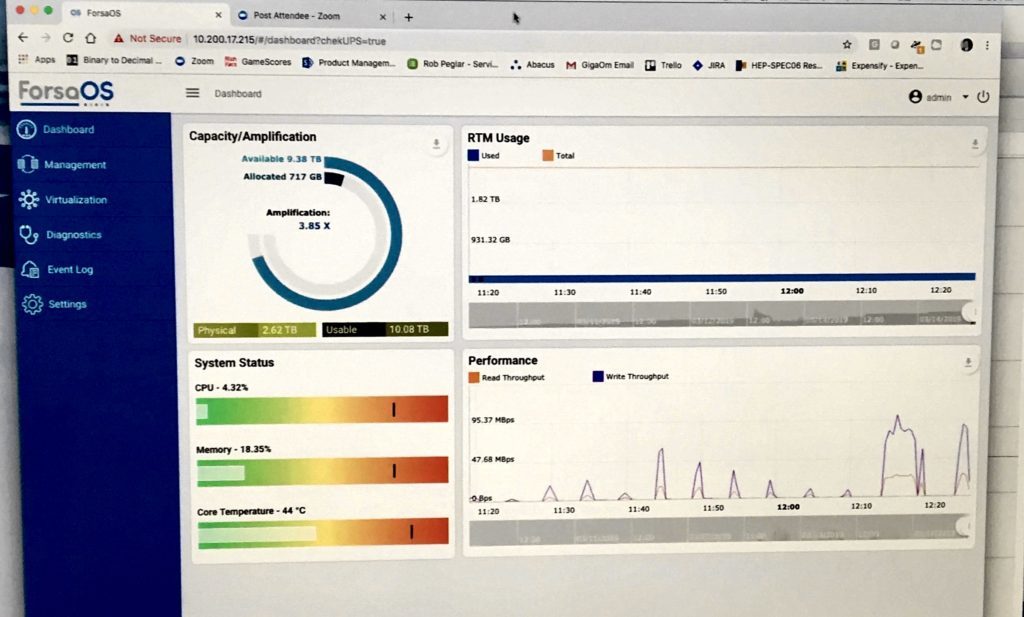Today’s storage briefs include Violin arrays adopting NVMe, NEC using Scale Computing to build a hyperconverged offering, Formulus Black getting its software added to HPE servers but not by HPE, and Hitachi Vantara bigging up object storage.
NEC HCI with Scale Computing
NEC has launched a hyperconverged infrastructure system that combines its hardware with Scale Computing’s HC3 software.
The NEC HCI appliance uses NEC’s D120h high-density server chassis, which can host four individual server nodes.

It is pre-configured in three levels – base, mid-range and power – and can be customised if pre-packed models don’t meet the needs of a customer.
The software, with in-built hypervisor, is pre-installed, and the customer just needs to add networking information to deploy the appliance.
New appliances can be added into a running cluster seamlessly and within minutes. Different models and capacities can be used together in various combinations to scale out resources as needed.
NEC’s HCI product is available in calendar Q2 2019 through its channel partners.
Hitachi Vantara’s IDC object survey
Hitachi Vantarra has sponsored an IDC InfoBrief, titled “Object Storage: Foundational Technology for Top IT Initiatives.” In the survey, 80 per cent of respondents believe object storage can support their top three IT initiatives related to data storage – which include security, Internet of Things and analytics for unstructured data.
To date, object storage has been used predominately for archival, according to Hitachi Vantara. That’s about to change, with object storage also used as a production data store for analytics routines, the company argues.
It quotes Amita Potnis, IDC research manager, file and object-based storage systems: “As we continue to see adoption across all environments – both on-and off-premises – features like All-flash will help usher in new, more performant use cases beyond archiving that drive additional value for organisations.”
All-flash object stores will provide much faster data access than disk-based stores and the latest 96-layer QLC (4bits/cell) 3D NAND SSDs will provide more affordable flash storage than the current TLC (3bits/cell) 64-layer 3D NAND.
The company supplies its HCP object storage platform and Pentaho analytics software. The all-flash HCP G10 configuration is the fastest performer. But Hitachi V said it has also sped up disk-based models with Skylake processors, and added capacity with 14TB disk drives and more drive bays in the product chassis.
Violin and NVMe
Violin Systems is adding NVMe SSDs to its XVS 8 all-flash array, lowering data access latency and also doubling usable capacity to 151TB.
According to IDC, by 2021 NVMe-based storage systems will drive over 50 per cent of all primary external storage system revenues. After that NVMe will be table stakes in all-flash arrays, meaning customers won’t buy all-flash arrays that don’t have NVMe drive support.
The software in the 3U XVS 8 provides deduplication and compression and effective capacity is up to six times greater than the usable capacity.
Formulus Black and HPE Proliants
Formulus Black has signed a reseller deal with Nth Generation, a US IT consulting and engineering firm, to provide its ForsaOS software integrated with HPE ProLiant servers.
Wayne Rickard, Formulus Black’s chief marketing officer, said: “Nth Generation…will be able to deliver tailor-made solutions that satisfy the needs of customers requiring exceptional performance, even when utilising more-affordable, mid-tier Xeon processors.”
ForsaOS uses bit-marker technology to run applications in memory much faster than if they were run with working sets partially in memory and partially in storage. To accomplish this, CPUs have to do extra work in decoding and encoding bit markers.
Testing on an HPE ProLiant DL380 Gen10 server, featuring mid-range Intel Xeon Gold 6126 processors and 24 x 32GB HPE DDR4-2666 MT/s DIMMs, yielded performance from 4.5 to 7.8 million random 4K IOPs. Average latencies for writes were 2.8µs and reads were 1.8µs per IOP with CPU utilisation below 50 per cent.
The results were achieved running VDBENCH on ForsaOS in host mode (non-virtualized). Formulus Black claims this performance is unmatchable by any SSD or other I/O-bound technology.

ForsaOS treats memory as storage and completes in-memory system backup and restoration in minutes instead of hours or days, according to Forumulus Black. By identifying and encoding data patterns using algorithms, the software enables more data to be securely persisted in memory, using powerfail protection to write DRAM contents to storage if power is lost.
The software stack can run any workload in memory without modification on any server.







